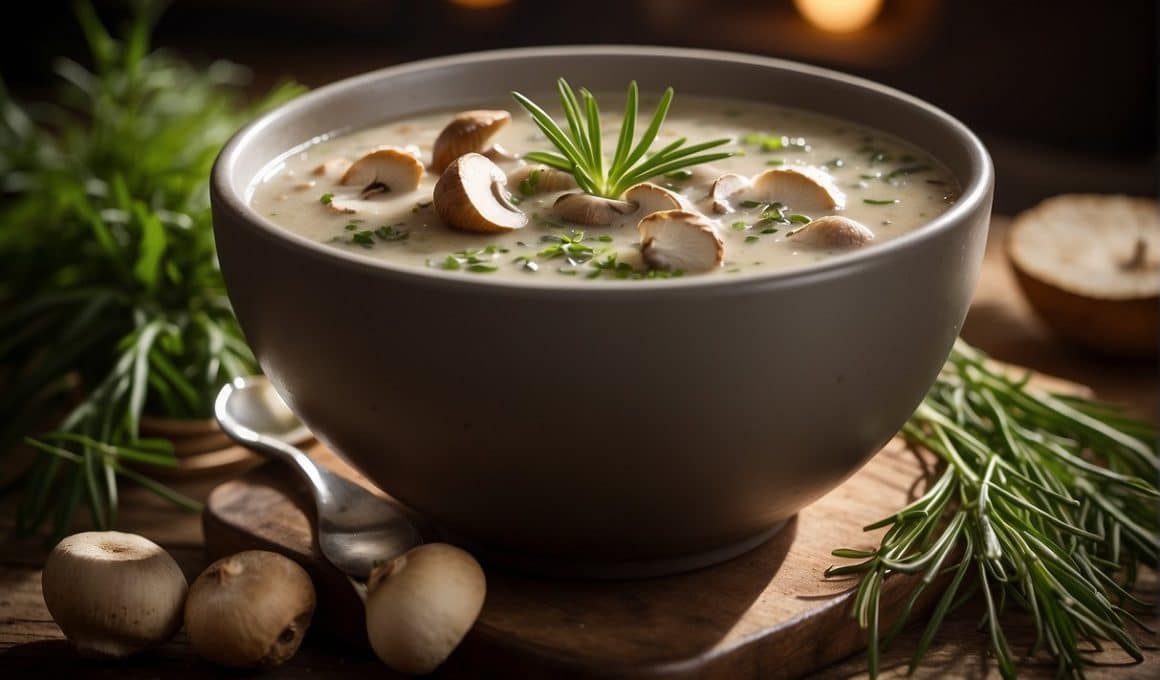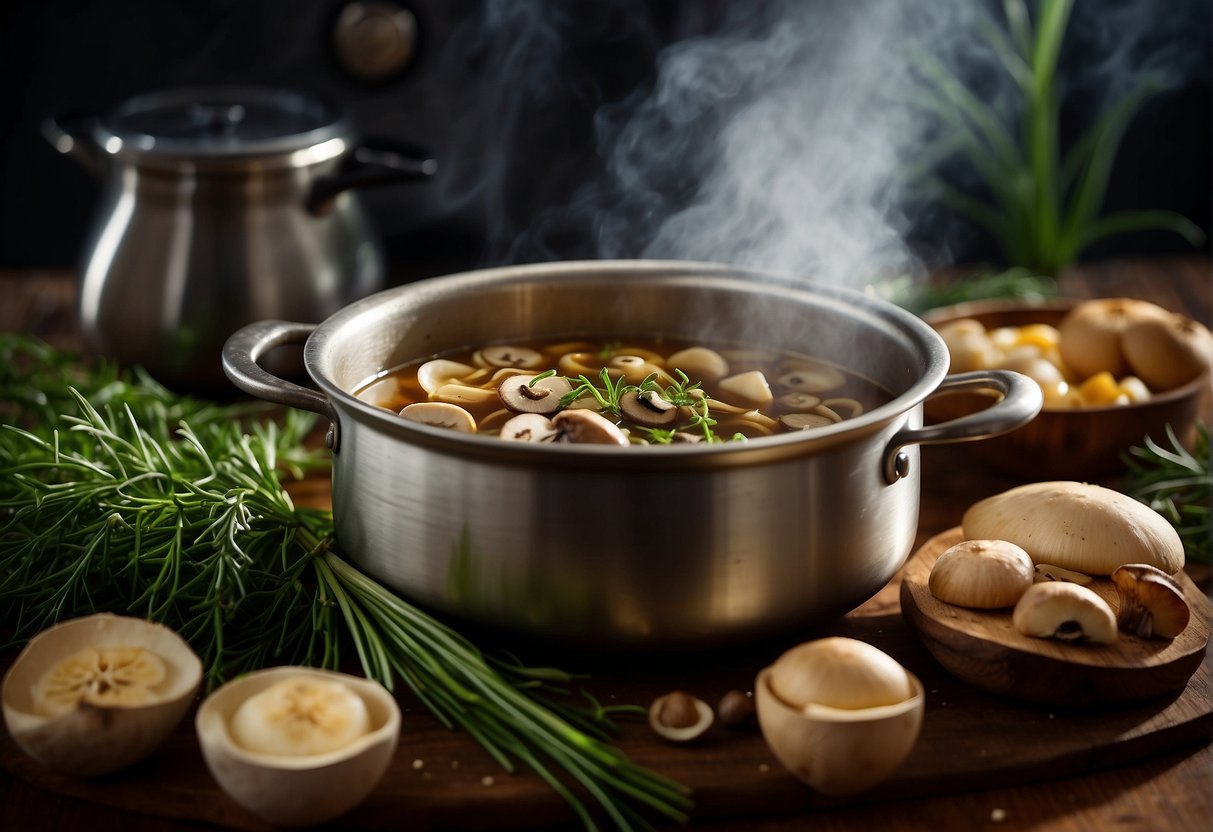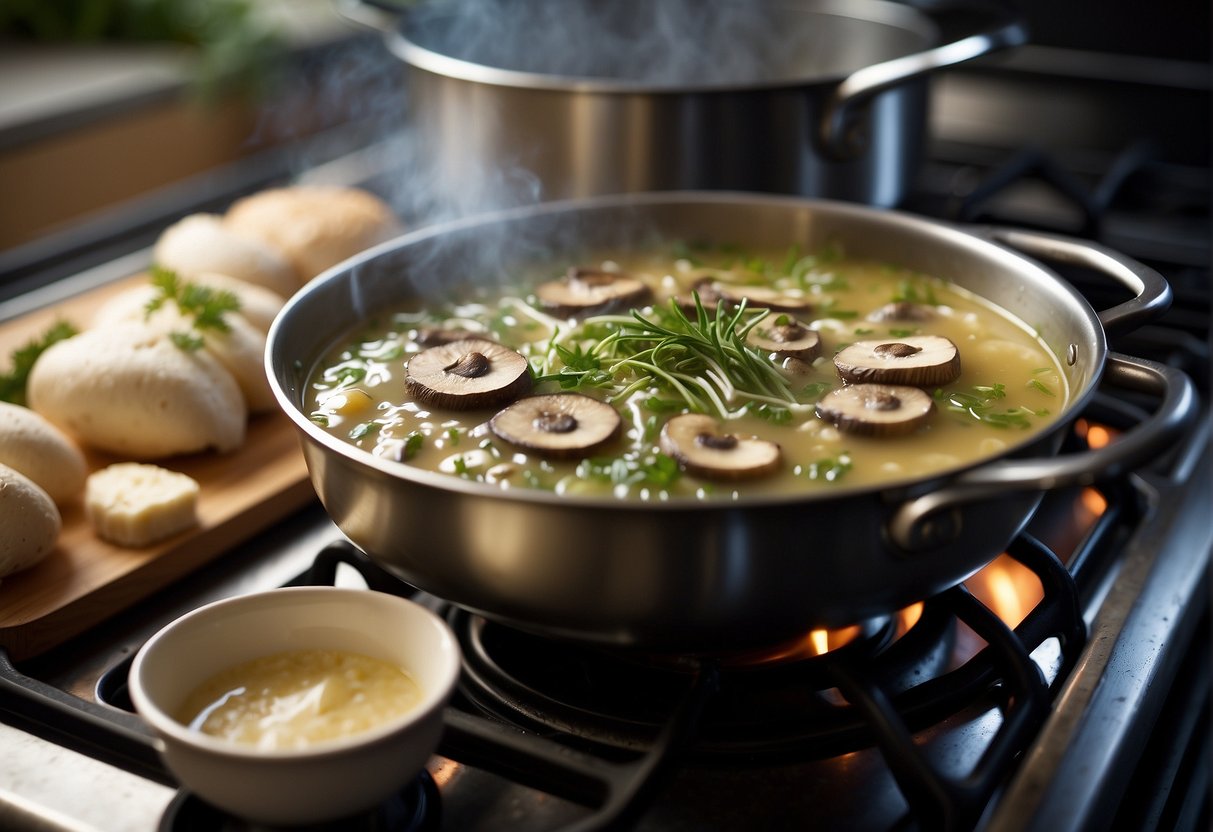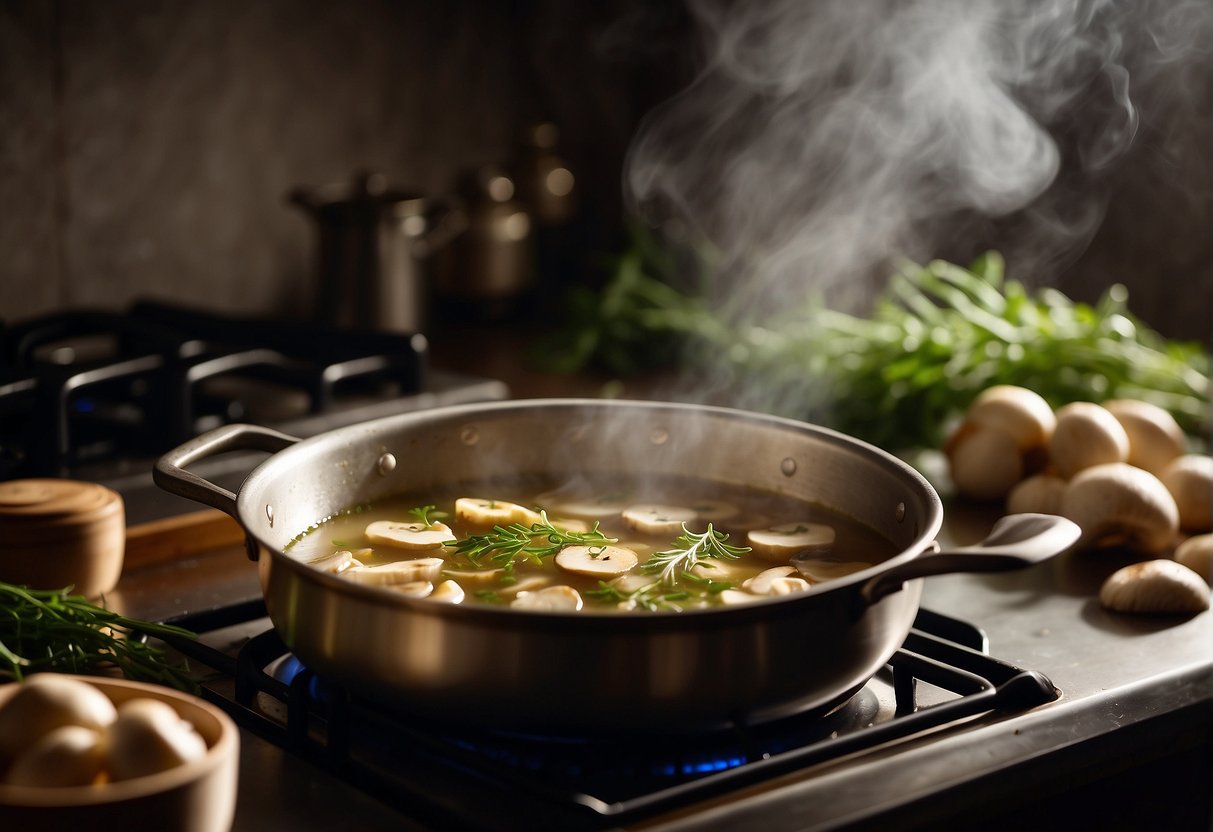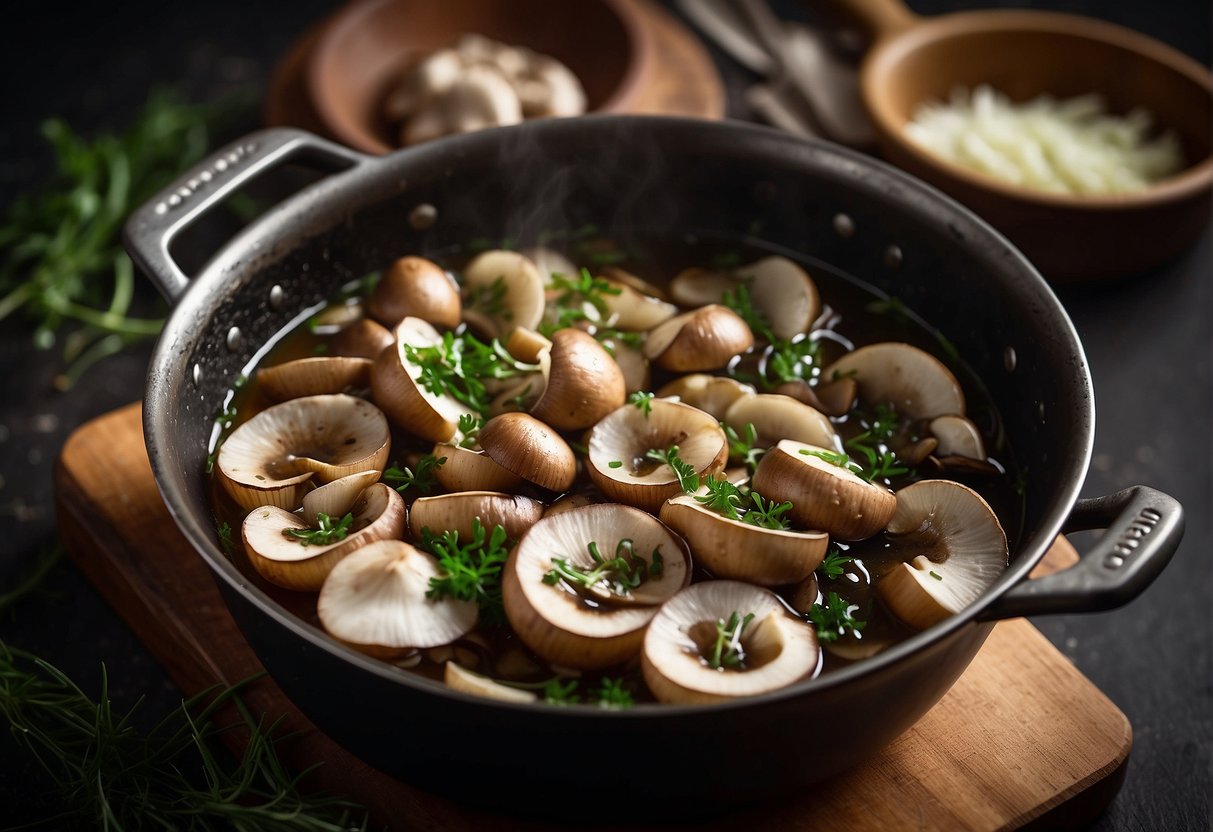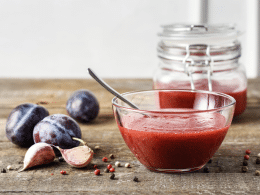Mushroom and tarragon soup combines the earthy depth of mushrooms with the subtle anise-like flavor of tarragon, creating a harmonious blend that’s perfect for a comforting meal. Not only is this dish a delight for the senses with its creamy texture and aromatic herbs, but it also offers a host of nutritional benefits. Mushrooms provide valuable nutrients including selenium, potassium, and B vitamins, while tarragon adds a unique taste plus a little extra antioxidant punch.
When I make mushroom and tarragon soup, my kitchen is filled with the warm, inviting flavors that hint at the soup’s European origins. I love how versatile this soup can be; it’s elegant enough for a dinner party and simple enough for a weeknight meal. Plus, for those with dietary restrictions, it’s easy to find variations that are gluten-free, dairy-free, or vegan, ensuring everyone can enjoy a bowl of this savory classic.
Key Takeaways
- Mushroom and tarragon soup is a nourishing dish with a balance of flavors.
- It’s suitable for various diets and easy to adapt with recipe variations.
- The soup is a classic recipe, ideal for both casual and refined occasions.
Origins and History
The history of mushroom soup has a rich tapestry, woven particularly through French and Russian influences. In the culinary scene of the 18th and 19th centuries, French chefs, cooking for Russian nobility, encountered the extensive use of mushrooms in local dishes. This cross-cultural exchange led to the creation of mushroom-based soups, which were refined over time.
As for tarragon, my research indicates that this herb has been an integral part of European cuisine, particularly in France, for centuries. Its distinctive anise-like flavor complements a variety of soups and sauces, including those featuring mushrooms. The combination of mushrooms and tarragon isn’t just a coincidence of flavors; it’s a deliberate match that has stood the test of time, showcasing how ingredients can be mutually enhanced.
Cream soups, which often include mushroom and tarragon varieties, trace their origins back to mid-18th century France. These soups were a demonstration of culinary finesse, bringing smoothness and richness to the forefront of the gastronomic experience.
While many soup recipes evolved from serendipitous discoveries or simple necessity, the mushroom tarragon soup seems to be a more modern creation that hinges on the love for umami and herbal fragrances combined in a creamy base. My appreciation for this dish grows each time I revisit its humble yet storied beginnings.
- French Influence: Cream soup innovation
- Russian Nobility: Introduction to diverse mushroom dishes
- Mushroom Soup: Gradual refinement by French chefs
- Tarragon: A historical herb with a strong culinary presence
Through these elements, I recognize that the origins and history of mushroom and tarragon soup are more than a confluence of ingredients; they represent a dialogue between cultures and the evolution of taste.
Health and Nutrition
When I prepare mushroom and tarragon soup, I focus on the health benefits it delivers. This soup can be a nutritious choice for a variety of diets and can easily be adapted to meet specific health requirements.
Nutritional Benefits
Mushrooms are a low-calorie food, yet they’re dense in nutrients — particularly protein and potassium. Including mushrooms in this soup boosts one’s protein intake, which is essential for tissue repair and muscle growth. Additionally, potassium is vital for maintaining normal blood pressure and heart function.
Tarragon, an often-underestimated herb, not only provides a distinct flavor but also contributes beneficial phytonutrients. However, it’s worth acknowledging that while soup can be a source of nutrition, the vitamin D content in mushrooms may vary and shouldn’t be relied upon as the primary source.
If I’m looking to enhance the soup’s immunity-boosting potential, I might add garlic or onions, known for their positive impact on the immune system.
Dietary Variations
Vegan: To keep this soup vegan, I employ vegetable stock and skip any dairy-based cream. I may use almond or coconut milk to achieve creaminess.
Low-Fat: By omitting high-fat ingredients and using low-fat broth or water, the soup remains heart-healthy and waistline-friendly.
Dairy-Free/Gluten-Free: Ensuring the soup is dairy-free and gluten-free involves careful ingredient selection, such as avoiding flour as a thickener and substituting it with corn flour, which is a technique observed in Neils Healthy Meals.
As I prepare this soup, I remember its adaptability. It can be light and healthy, or rich and indulgent, depending on the ingredients I choose.
Ingredients Breakdown
When I create a mushroom and tarragon soup, I choose specific ingredients to achieve a harmonious blend of earthiness from the mushrooms and the unique, slightly anise-like flavor of tarragon. Let’s break down the key components, so you understand their roles and the options available.
Mushrooms Variety
Mushrooms are the star of the dish, providing a meaty texture and deep flavor. White mushrooms offer a milder taste, while cremini and button mushrooms are my typical go-tos for their more robust flavor. For those who enjoy a stronger, nuttier character, chestnut mushrooms or portobello are fantastic alternatives.
Herbs and Spices
The namesake tarragon imparts a distinctive bittersweet taste reminiscent of anise. I find that fresh tarragon integrates better into the soup, giving a brighter note than the dried version. Garlic adds depth, and a careful balance of salt and pepper is crucial to enhance and meld the flavors without overwhelming them. Occasionally, I might sprinkle in some parsley for a fresh counterpoint.
Base Ingredients
I build the foundation of the soup with olive oil or butter, which provides a rich flavor. Onions or sometimes a tenderly sautéed leek form the aromatic base. I whisk in flour to thicken the soup, achieving creaminess without heavy cream. Milk further enriches the texture and mellows the earthy tones. A good vegetable stock is paramount as it infuses every spoonful with a savory essence that supports all the other ingredients.
Step-by-Step Cooking Guide
For those ready to create a comforting bowl of mushroom and tarragon soup, this guide will walk you through the preparation, cooking, and finishing stages. I’ll ensure that each step is detailed and easy to follow, aiming to make your cooking experience as smooth as possible.
Preparation Instructions
- Gather Ingredients: First, I assemble all necessary ingredients for my soup recipe which typically includes a blend of button and cremini mushrooms, fresh tarragon, garlic, and seasonings.
- Vegetable Prep: I clean and chop the mushrooms uniformly to ensure even cooking. Garlic is minced, and tarragon leaves are stripped from their stems and finely chopped.
- Equipment Ready: My trusty food processor or blender is on standby for later steps, and I have a large pot ready for cooking.
Cooking Process
- Sautee Aromatics: On medium-low heat, I melt butter in the pot before adding minced garlic and other aromatics, cooking until they’re translucent and fragrant.
- Mushrooms: The chopped mushrooms join the fray, getting sauteed until soft and golden. This step is crucial for building the deep, earthy flavor base.
- Liquid Addition: I pour in vegetable stock and white wine, turning up the heat to allow the mixture to reach a simmer. Then I reduce the heat and let the soup simmer to meld the flavors together.
Finishing Touches
- Blend Soup: Once the ingredients are fully cooked, I carefully transfer the soup in batches to the food processor or blender, pulsing until I achieve a smooth consistency that’s still slightly textured.
- Final Season: Back in the pot goes the soup, and I stir in half-and-half, allowing it to heat through. I taste and adjust the seasoning with sea salt and cracked black pepper, incorporating the fresh tarragon for that final herbaceous accent.
- Serve: The soup is now ready to serve. A typical recipe yields about four servings, perfect for a hearty meal. Each bowl is garnished with a sprig of tarragon to elevate the presentation.
Serving and Pairing
When I serve mushroom and tarragon soup, it’s essential to consider the accompanying dishes and drinks that can complement its rich and aromatic flavors. Whether for lunch or dinner, the right pairings can elevate the dining experience.
Accompaniments
When I think about what to serve with my mushroom and tarragon soup, I always lean towards a good, crusty piece of bread. For an elegant lunch, I often serve my soup with a warm, gluten-free baguette that’s perfect for dipping and scooping up the hearty chunks of mushroom. A fresh green salad dressed with a light vinaigrette makes an excellent side, balancing the creaminess of the soup.
Wine Pairing
Choosing the right wine to pair with mushroom and tarragon soup can make all the difference in a dinner setting. I find that a dry sherry with its nutty and slightly sweet notes complements the earthy flavor of the mushrooms exquisitely. For those who prefer wine, a Chardonnay with hints of oak pairs well with the woodsy essence of the herbs and the depth of the mushrooms. Alternatively, the bright acidity and fruit notes of a Pinot Noir can cut through the richness of the soup, creating a harmonious balance on my palate.
Storage and Preservation
When I make mushroom and tarragon soup, I always consider the best ways to store and preserve it, since I often prepare meals in advance. Here’s how I ensure my soup stays fresh and delectable.
Refrigerating:
- After cooking, I let the soup cool down to room temperature.
- I then pour it into an airtight container; glass is my go-to option.
- In the fridge, the soup stays good for up to 3-4 days.
Freezing:
Freezing is ideal when I want to extend the shelf life for weeks or even months. Here’s my freezing process:
- Cool the soup completely before freezing.
- Portion the soup into freezer-safe bags or containers, leaving some space at the top as the liquid will expand when it freezes.
- Label with the date; this soup should be consumed within 2-3 months for the best quality.
Thawing and Reheating:
- I thaw the soup overnight in the fridge or use the defrost setting on my microwave.
- While reheating, I stir occasionally to ensure even warmth.
- If the soup has separated after freezing, a quick whisk or blend can restore its creamy consistency.
I avoid refreezing previously frozen soup as this can affect the taste and texture. By following these storage and preservation methods, I ensure that my mushroom and tarragon soup remains a savory and convenient meal ready to enjoy whenever I desire.
Recipe Variations
In my kitchen, the beauty of mushroom and tarragon soup lies in its versatility. Whether catering to dietary restrictions or simply wanting to spice things up, personal touches make this dish uniquely satisfying.
Alternative Ingredients
If you’re aiming for a dairy-free or vegan version of this classic soup, there are a variety of substitutes I can recommend. For the creamy texture that you love, consider using plant-based milk like almond or coconut milk. Nutritional yeast can also be stirred in to give a cheesy flavor without actual dairy. For those looking to keep it gluten-free, swap out any flour used as a thickener with a gluten-free alternative or use pureed potato as a thickening agent.
- Dairy to Dairy-Free Substitutes:
- Full Cream → Cashew or Coconut Milk
- Butter → Olive Oil or Vegan Margarine
- Gluten Flour to Gluten-Free Thickeners:
- Wheat Flour → Rice Flour or Cornstarch
- Croutons → Gluten-Free Bread or Potatoes
Creative Additions
Bringing a fresh perspective to the classic mushroom and tarragon soup, I often explore with additional ingredients. Chopped parsley adds a fresh burst of color and flavor. Button mushrooms are the usual choice, but feel free to get creative with varieties like cremini or shiitake for different flavors and textures. A garnish of roasted nuts can offer a delightful crunch – just ensure they align with any allergen concerns.
- Flavor Enhancers:
- Tarragon → Fresh Parsley or Thyme
- Standard Mushrooms → Mix of Wild Mushrooms
- Texture Variations:
- Creamy Base → Chunky with Chopped Vegetables
- Smooth → Add Coarsely Chopped Nuts for Crunch
Adjusting recipes to suit my taste and nutritional preferences keeps cooking exciting and ensures that every bowl of mushroom and tarragon soup I serve is a reflection of my personal touch.
Kitchen Tips and Tricks
In my experience, mastery in the kitchen comes down to the smart, small practices that save time and enhance flavor. That’s why I focus on proper technique and care in the little things, like cleaning mushrooms and storing herbs, to make the cooking process both enjoyable and efficient.
Mushroom Cleaning
When I clean mushrooms, I avoid rinsing them under water as they can quickly absorb moisture and become soggy. My trick is to use a soft-bristle brush or a slightly damp paper towel to gently wipe away any dirt. This keeps them dry and maintains their texture, which is crucial for a soup that shines in simplicity and savor.
Herb Storage
For herb storage, tarragon should be treated with care. I wrap fresh tarragon in a slightly damp paper towel and then place it in a plastic bag in the fridge. This method can keep the tarragon aromatic and lively for a week or more. Inspired by this practice, I ensure all my herbs are stored correctly to maintain their freshness and invigorate my dishes with full flavor.
Culinary Inspiration
I’ve always found comfort in the warmth of a bowl of soup, especially on a cold day. The combination of mushrooms and tarragon offers not just warmth but also a depth of flavor that elevates a simple dish to something truly special. When I think of comforting meals, a filling soup that marries the earthy tones of mushrooms with the subtle, slightly anise-like flavor of tarragon immediately comes to mind.
In my kitchen, I lean on the versatility of herbs to transform the usual into the extraordinary. Tarragon is one such herb that should be celebrated for its ability to add a unique, fresh flavor to dishes. Whether I incorporate it into a creamy soup or sprinkle it atop a finished dish as a garnish, it becomes a standout ingredient that enlivens the palate.
Here’s a simple breakdown of my approach to creating this delightful soup:
- Selecting Mushrooms:
- Aim for a mix, such as button and cremini, for complexity in taste.
- Incorporating Herbs:
- Fresh tarragon is best, added just before blending to preserve its essence.
- Layering Flavors:
- Sauté onions and garlic first for a savory base.
- Introduce mushrooms and cook until they release their juices.
- Season with salt, pepper, and tarragon.
My approach always involves paying close attention to the quality of ingredients—this is paramount. Fresh, high-quality mushrooms and herbs make all the difference. When these elements come together, the result is a hearty, filling meal that not only satisfies hunger but also provides solace against the chill of a cold day.
Frequently Asked Questions
In this section, I’ll be addressing some common inquiries about mushroom and tarragon soup, from vegan substitutions to cooking methods and health-focused variations.
What are some creamy substitutes I can use in mushroom and tarragon soup for a vegan alternative?
To create a rich, creamy texture in vegan mushroom and tarragon soup, I often recommend using coconut milk, cashew cream, or silken tofu blended until smooth. These substitutes add creaminess without dairy.
How do you make a simple mushroom and tarragon soup?
A simple mushroom and tarragon soup starts with sautéing onions, garlic, and fresh mushrooms. After they soften, I add in vegetable broth, chopped tarragon, and other seasonings, then simmer. The soup can then be puréed to your desired consistency.
Can mushroom and tarragon soup be prepared in a slow cooker?
Yes, mushroom and tarragon soup can be prepared in a slow cooker by adding all ingredients into the cooker and letting it simmer on low for a few hours. This allows the flavors to meld beautifully.
What is a healthy variation of mushroom and tarragon soup?
For a healthier mushroom and tarragon soup, I choose to purée part of the soup to thicken it naturally, use low-sodium vegetable broth, and add plenty of herbs for flavor, avoiding the need for heavy cream or excess oil.
How can I thicken mushroom and tarragon soup without using heavy cream?
To thicken the soup without heavy cream, I often use a roux made from a little butter and flour, or for a gluten-free option, I might use arrowroot or cornstarch dissolved in water. Adding puréed potatoes or white beans also works well.
What are the benefits of adding leek to mushroom and tarragon soup?
Adding leek to mushroom and tarragon soup not only provides a subtle onion-like flavor but also contributes vitamins and minerals to the dish, enhancing its nutritional profile.





